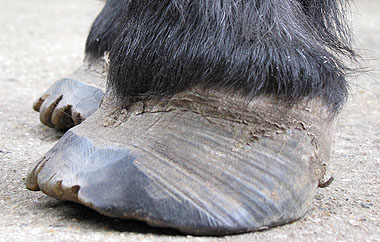Cushing's Disease Is Common In Laminitic Horses As Young As 10 Years Old
 13 years ago
13 years ago  3929 views
3929 views
Posted
30th August, 2012 09h49
 PPID - new data demonstrates that Cushing’s disease is common in laminitic horses as young as 10 years old1
Following the hugely successful ‘Talk About Laminitis’ campaign which saw over 3,100 horses tested for PPID (Cushing’s disease) during the spring, data collected by Boehringer Ingelheim Vetmedica has demonstrated that one third of laminitic middle aged horses (between the ages of 10 and 15 years) tested positive for the disease1.
“Although the common perception is that PPID is a disease of only older horses and ponies, the ageing process is progressive and this data from over 330 participating veterinary practices1 indicates that horses and ponies in the 10 to 15 age bracket are also frequently affected,” comments Liz Barrett, equine sales and marketing manager at Boehringer Ingelheim Vetmedica.
The company is urging veterinary surgeons to test laminitic or foot-sore horses for PPID this autumn, as this is when there is a greater difference between horses with PPID and those free of the disease2, 3. In support of this, Boehringer Ingelheim Vetmedica will be re-launching its highly popular disease awareness initiative ’Talk About Laminitis’ which is complemented by free ACTH blood tests* during September, October and November. To participate in the scheme, veterinary surgeons can download free ACTH blood test vouchers from www.talkaboutlaminitis.co.uk. Simply attach the voucher to the ACTH sample submission form and the ACTH laboratory fees will be free of charge*.
Dr Catherine McGowan BVSc DipVetClinStud MACVSc PhD DEIM DipECEIM FHEA MRCVS from the University of Liverpool, comments: “It is very important to test horses for PPID the first time they present with laminitis because what we want to avoid is recurrence of that laminitis. If it does reoccur, the damage will be worse and the chances of that horse having a successful long-term recovery will be diminished.”
For further information on ‘Talk About Laminitis’, PPID or Prascend®, the first licensed product for the treatment of PPID, please visit www.talkaboutlaminitis.co.uk, contact your Boehringer territory manager or call 01344 746959.
ReferencesBoehringer Ingelheim Vetmedica. Resting ACTH results of 724 horses aged 10 to 15 years.McGowan, T.W., Pinchbeck, G.L. and McGowan, C.M. (2012) Evaluation of basal plasma a-melanocyte-stimulating hormone and adrenocorticotrophic hormone concentrations for the diagnosis of pituitary pars intermedia dysfunction from a population of aged horses. Equine Veterinary Journal. DOI: 0.1111/j.2042-3306.2012.00575.xCopas, V.E.N. and Durham, A.E. (2011) Circannual variation in plasma adrenocorticotropic hormone concentrations in the UK in normal horses and ponies, and those with pituitary pars intermedia dysfunction. Equine Veterinary Journal 44, 440-443.*Free laboratory fees through The Liphook Equine Practice Laboratory
Produced by the makers of Prascend®. Prascend® contains Pergolide mesylate. Prescription only medicine. Further information available from Boehringer Ingelheim Vetmedica, Bracknell, Berkshire, RG12 8YS, UK. Date of preparation: February 2012, AHD 7061 Use Medicines Responsibly (www.noah.co.uk/responsible)
PPID - new data demonstrates that Cushing’s disease is common in laminitic horses as young as 10 years old1
Following the hugely successful ‘Talk About Laminitis’ campaign which saw over 3,100 horses tested for PPID (Cushing’s disease) during the spring, data collected by Boehringer Ingelheim Vetmedica has demonstrated that one third of laminitic middle aged horses (between the ages of 10 and 15 years) tested positive for the disease1.
“Although the common perception is that PPID is a disease of only older horses and ponies, the ageing process is progressive and this data from over 330 participating veterinary practices1 indicates that horses and ponies in the 10 to 15 age bracket are also frequently affected,” comments Liz Barrett, equine sales and marketing manager at Boehringer Ingelheim Vetmedica.
The company is urging veterinary surgeons to test laminitic or foot-sore horses for PPID this autumn, as this is when there is a greater difference between horses with PPID and those free of the disease2, 3. In support of this, Boehringer Ingelheim Vetmedica will be re-launching its highly popular disease awareness initiative ’Talk About Laminitis’ which is complemented by free ACTH blood tests* during September, October and November. To participate in the scheme, veterinary surgeons can download free ACTH blood test vouchers from www.talkaboutlaminitis.co.uk. Simply attach the voucher to the ACTH sample submission form and the ACTH laboratory fees will be free of charge*.
Dr Catherine McGowan BVSc DipVetClinStud MACVSc PhD DEIM DipECEIM FHEA MRCVS from the University of Liverpool, comments: “It is very important to test horses for PPID the first time they present with laminitis because what we want to avoid is recurrence of that laminitis. If it does reoccur, the damage will be worse and the chances of that horse having a successful long-term recovery will be diminished.”
For further information on ‘Talk About Laminitis’, PPID or Prascend®, the first licensed product for the treatment of PPID, please visit www.talkaboutlaminitis.co.uk, contact your Boehringer territory manager or call 01344 746959.
ReferencesBoehringer Ingelheim Vetmedica. Resting ACTH results of 724 horses aged 10 to 15 years.McGowan, T.W., Pinchbeck, G.L. and McGowan, C.M. (2012) Evaluation of basal plasma a-melanocyte-stimulating hormone and adrenocorticotrophic hormone concentrations for the diagnosis of pituitary pars intermedia dysfunction from a population of aged horses. Equine Veterinary Journal. DOI: 0.1111/j.2042-3306.2012.00575.xCopas, V.E.N. and Durham, A.E. (2011) Circannual variation in plasma adrenocorticotropic hormone concentrations in the UK in normal horses and ponies, and those with pituitary pars intermedia dysfunction. Equine Veterinary Journal 44, 440-443.*Free laboratory fees through The Liphook Equine Practice Laboratory
Produced by the makers of Prascend®. Prascend® contains Pergolide mesylate. Prescription only medicine. Further information available from Boehringer Ingelheim Vetmedica, Bracknell, Berkshire, RG12 8YS, UK. Date of preparation: February 2012, AHD 7061 Use Medicines Responsibly (www.noah.co.uk/responsible)More from
- Vetsure Named Business of the Year at 2025 SME National Business Awards
- Home of hope for Romania's dogs: The pioneering shelter doing things differently
- Pioneering new locum platform transforming veterinary landscape
- Key Stakeholders unite to advance helmet design for equine veterinary professionals
- Hallmarq hails transformational equine imaging technology
